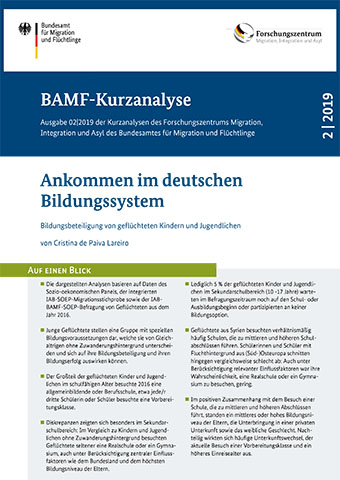Arriving in the German education system ,

The BAMF’s Brief analysis 2|2019 addresses the arrival of refugee children and juveniles in the German education system.
Using data from the IAB-BAMF-SOEP refugee survey, the Socio-Economic Panel (SOEP) and the integrated IAB-SOEP migration sample, the educational participation of children and juveniles with a refugee background was compared with that of peers with or without a migration background in the second half of 2016.
Young refugees as a group with special educational needs
The prerequisites for a successful educational career are comparatively difficult for refugee children and juveniles: interrupted or incomplete educational biographies, family and psychological burdens as well as a lack of knowledge of German and poor resources cause refugee minors to fall behind children and juveniles with or without a migration background in the education system.
The majority are enabled to participate in education, but there are still differences vis-à-vis the comparison groups.
The majority of school-age children and juveniles were attending a general or vocational school at the time when the survey was conducted. Participation in the education system has therefore already been largely successful after their short period of residence.
Contact

Cristina Gockeln
Position: Researcher
Differences between juveniles with and without a migration background were particularly evident in the upper age groups and in secondary education: Juvenile refugees between the ages of 11 and 14 were attending primary schools more frequently than their peers, whereas refugee minors between the ages of 15 and 17 were attending a general school less frequently than their peers with or without a migration background.
Refugee students were less likely to attend an intermediate secondary school (Realschule) or a grammar school (Gymnasium) than students with or without a migration background. However refugee minors were more likely to attend a lower secondary school (Hauptschule) or another educational institution such as a vocational school. Refugees from Syria were particularly well placed in secondary school, whilst juvenile refugees from (South-) Eastern Europe were particularly poorly placed.
Author of the Brief analysis: Cristina de Paiva Lareiro
The Brief analysis is only available in German.
